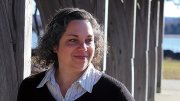One of the world’s leading experts on nutrition during pregnancy almost became an archaeologist. When Emily Oken faced a choice between organic chemistry or Greek language as a Princeton undergraduate, both at 10 a.m. , she settled on Greek during the semester and chemistry in the summer. Now Hamilton professor of population medicine, Oken had worked on archaeological digs near Philadelphia during high school and later juggled pre-medical requirements with a classics major and summer expeditions in Greece. (She fondly remembers dropping into a well to excavate artifacts in Santorini.) Eventually, archaeology became an avocation. She entered Harvard Medical School in 1991 and got interested in public health and prevention while studying why people adopt risky behaviors and how education can promote healthier habits. After finishing her residency in 2000, she joined Project Viva, an epidemiological study of nutrition and toxicant influences on pregnancy outcomes and the long-term health of mother and child. “It’s not just the behaviors that you do as an adult…that influence your risk for chronic disease,” explains Oken, “but even behaviors that happen very early in life, or prenatally.” Her first big challenge, in 2001, was to assess whether fish consumption during pregnancy was safe (yes, with caveats!). A mother of two children just younger than those in the study, she found the work personally relevant, too. Oken has since worked with approximately 1,500 enrolled mother-child pairs to investigate the fetal origins of obesity, the effects of smoking during pregnancy, and the consequences of sleep deficiencies through infancy. In 2016, she became the project’s principal investigator. Though she has spent two decades with Project Viva, she still enjoys unearthing new conclusions from troves of data—not so far from archaeology after all.
Emily Oken's Studies on Nutrition During Pregnancy
Emily Oken's Studies on Nutrition During Pregnancy
Oken's path from archaeology to epidemiology

Emily Oken
Photograph courtesy of Harvard Medical School
You might also like
Mount Vernon, Historic Preservation, and American Politics
Anne Neal Petri promotes George Washington and historic literacy.
Landscape Architect Julie Bargmann Transforming Forgotten Urban Sites
Julie Bargmann and her D.I.R.T. Studio give new life to abandoned mines, car plants, and more.
Preserving the History of Jim Crow Era Safe Havens
Architectural historian Catherine Zipf is building a database of Green Book sites.
Most popular
Explore More From Current Issue

Getting to Mars (for Real)
Humans have been dreaming of living on the Red Planet for decades. Harvard researchers are on the case.

A Forgotten Harvard Anthem
Published the year the Titanic sank, “Harvard’s Best” is a quizzical ode to the University.

The 1884 Cannibalism-at-Sea Case That Still Has Harvard Talking
The Queen v. Dudley and Stephens changed the course of legal history. Here’s why it’s been fodder for countless classroom debates.




